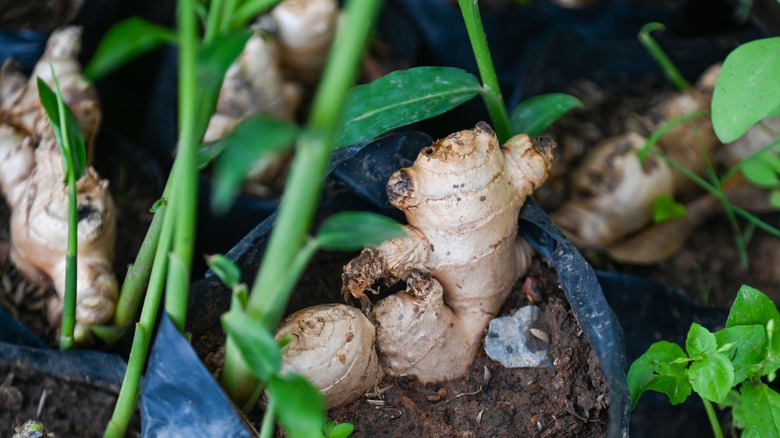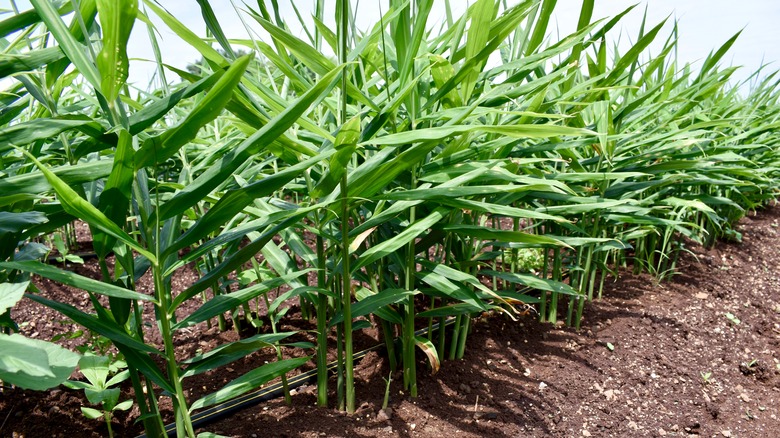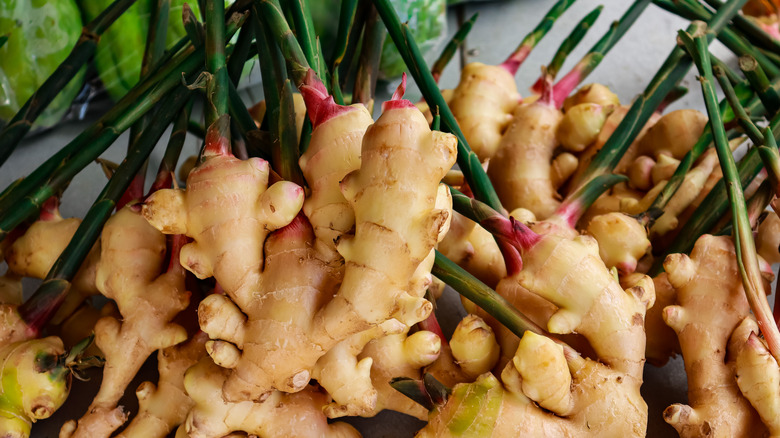Can You Grow Ginger From A Piece Of Ginger? Here's What You Should Know
If you've ever planted a potato that has aged out of its culinary usefulness, or enjoyed a 4-foot avocado plant sprouting up from a seed suspended in a glass of water on toothpicks, you might already know that lots of grocery store scraps can be regrown to produce more food at no cost. It's true of ginger as well—not only can you grow ginger from a leftover piece of ginger rhizome, but that's the way it's usually grown. Ginger is a beautiful plant that's also healthy for your garden, and it will grow as a warm-season annual throughout the contiguous United States and indoors even longer. But while you can successfully grow ginger from produce aisle scraps, there are a few things you can do to improve your odds of success.
Ginger gives you a lot of bang for your buck... or for your dime, in this case. It's tasty, versatile, and inexpensive, and made even less expensive by using your waste to grow more. Like turmeric, another rhizome plant (rhizomes are underground stems from which the above-ground plant and the actual roots grow), it's a process of burying a piece (or 12) at the right depth. But because grocery store ginger is often treated with a growth inhibitor and isn't, of course, certified disease-free, it's a better bet to plant ginger from nurseries or seed companies. Planting culinary ginger from any source can be rewarding, but you will need to pay attention to signs of potential trouble.
Planting store-bought ginger
Ginger is a tropical plant that requires warm soil, growing best in soils that are 70 degrees Fahrenheit and above. But you can start your ginger indoors in February or March and even finish it indoors as well to extend the growing season. More on that later. It takes a couple of days to properly prepare ginger for planting, but there's not a lot of work involved. Begin by cutting the rhizome into 1- to 1 ½-inch chunks, each of which should have at least one "eye" — visible bud-like sites from which stems and roots will grow. Because of the growth retardant applied to ginger sold in supermarkets, you'll usually want to soak your ginger overnight, or as long as a day, to wash away as much of the chemical treatment as possible. Then, it's a good idea to allow the rhizome to dry and form a callus over your cuts before planting. Bury the pieces no more than 4 inches deep, since the rhizome will need to be close to the surface of the soil to grow properly.
Plant the ginger sideways (so the roots and shoots start growing horizontally) in soil that's well-drained and rich in organic material. It will need at least two to five hours of sunlight per day. The 2- to 3-foot-tall plants will need protection from strong winds and will benefit from being mulched.
Growing and harvesting ginger
Throughout its growth cycle, it's important to protect your ginger from freezing. If necessary, you can move the whole plant indoors or into a greenhouse for a couple of months to extend the growing time. You can reduce watering during cooler months, but keep the soil moist. Brown leaf tips usually mean your plants need more water, while yellowing leaves indicate that the plant would benefit from more fertilizer. Plant with a slow-release fertilizer and apply a liquid fertilizer with lots of phosphorus every couple of weeks, depending on the richness of your soil. Pay attention to the growing plants to avoid the common mistakes (usually related to sun, water, disease, or pests) that everyone makes when growing ginger.
The ginger rhizome can be harvested any time after it's been growing for four months, so you have some decisions to make about harvesting as you plan its growth season. At four months, the "baby ginger" is less fibrous than the mature rhizome and doesn't need to be peeled, while the mature plant is typically harvested after eight to 10 months and after flowering. But sections will need to be fully mature to be replanted, if you want to keep your crop going beyond a single season, so keep that in mind as you plan. Replant your new cuttings immediately. You can store your harvested, unpeeled ginger for six months in the freezer or three weeks in your fridge.


